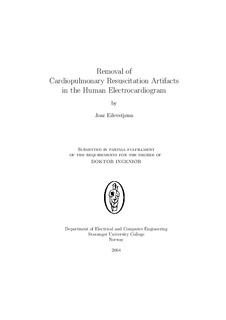| dc.contributor.advisor | Eftestøl, Trygve | nb_NO |
| dc.contributor.author | Eilevstjønn, Joar | nb_NO |
| dc.date.accessioned | 2014-12-19T13:42:39Z | |
| dc.date.accessioned | 2015-12-22T11:39:51Z | |
| dc.date.available | 2014-12-19T13:42:39Z | |
| dc.date.available | 2015-12-22T11:39:51Z | |
| dc.date.created | 2004-11-02 | nb_NO |
| dc.date.issued | 2004 | nb_NO |
| dc.identifier | 124970 | nb_NO |
| dc.identifier.isbn | 82-471-6398-5 | nb_NO |
| dc.identifier.uri | http://hdl.handle.net/11250/2368828 | |
| dc.description.abstract | Death from heart diseases is the most common type of mortality in western countries and the survival rate of cardiac arrest is dismally low. In the treatment of cardiac arrest, two therapeutic methods are most important: cardiopulmonary resuscitation (CPR; chest compressions and ventilations) and defibrillation (electrical shocks to restart a fibrillating heart).
An automated external defibrillator is commonly used for such shocks, and records and performs signal analysis on the electrocardiogram(ECG) in order to advice when to shock the patient. However, the mechanical activity during CPR introduces artifact components in the ECG. To perform reliable ECG signal analysis, CPR is therefore discontinued for a substantial time before the potential delivery of a shock. This wastes valuable therapy time, and if this hands-off time could be reduced or eliminated by removing these artifacts, it should improve the chance of return of spontaneous circulation.
We propose a method for removing CPR artifacts using a novel multichannel adaptive filter, the computationally efficient and numerically robust MultiChannel Recursive Adaptive Matching Pursuit(MC-RAMP) filter. Using the most realistic data set to date, human out-of-hospital cardiac arrest data of both shockable and non-shockable rhythms, we test MC-RAMP and evaluate the feasibility of ECG analysis during CPR. In our experiments we use a shock advice algorithm and individual ECG signal features to reach the conclusion that after CPR artifact filtering, ECG rhythm analysis during ongoing CPR is feasible.
Finally, we analyze and quantify the time intervals without blood flow (no flow time(NFT)) during external automatic defibrillation in cardiac arrest patients and show that these patients were not perfused around half of the time. We propose methods using CPR artifact filtering to reduce the NFT, and show their significant and promising potential. By introducing the proposed methods into defibrillators, the NFT would be significantly reduced, hopefully increasing the survival. | nb_NO |
| dc.language | eng | nb_NO |
| dc.publisher | Fakultet for informasjonsteknologi, matematikk og elektroteknikk | nb_NO |
| dc.relation.ispartofseries | Doktoravhandlinger ved NTNU, 1503-8181; 2004:91 | nb_NO |
| dc.subject | Signalbehandling | en_GB |
| dc.subject | Cardiopulmonary resuscitation | |
| dc.subject | Electrocardiogram | |
| dc.subject | Cardiac arrest | |
| dc.subject | Adaptive filter | |
| dc.subject | TECHNOLOGY: Information technology: Signal processing | |
| dc.title | Removal of Cardiopulmonary Resuscitation Artifacts in the Human Electrocardiogram | nb_NO |
| dc.type | Doctoral thesis | nb_NO |
| dc.source.pagenumber | 170 | nb_NO |
| dc.contributor.department | Norges teknisk-naturvitenskapelige universitet, Fakultet for informasjonsteknologi, matematikk og elektroteknikk, Institutt for elektronikk og telekommunikasjon | nb_NO |
| dc.description.degree | dr.ing. | nb_NO |
